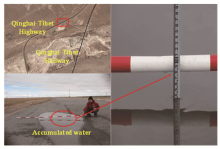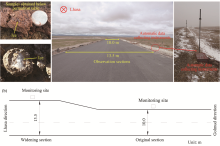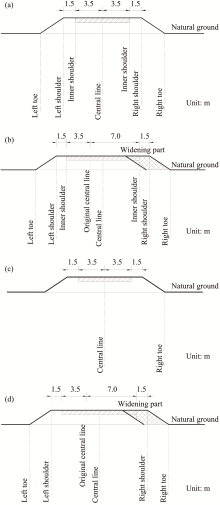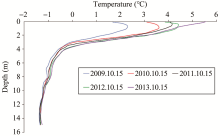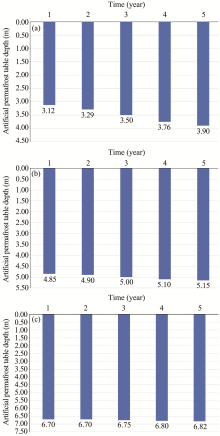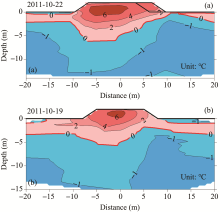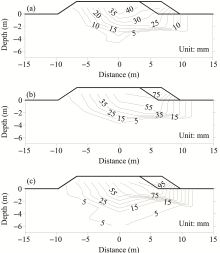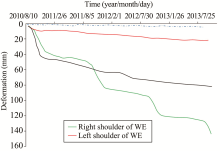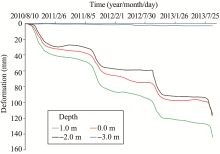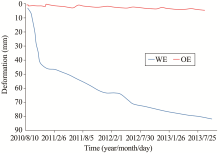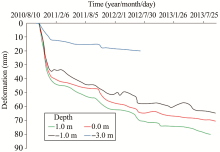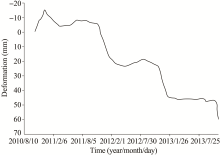Sciences in Cold and Arid Regions ›› 2021, Vol. 13 ›› Issue (2): 123–132.doi: 10.3724/SP.J.1226.2021.20037
• • 上一篇
A full-scale field experiment to study the thermal-deformation process of widening highway embankments in permafrost regions
ShuangJie Wang1,Long Jin1,3( ),Kun Yuan1,DongGen Chen1,JinPing Li1,Yi Song2,3
),Kun Yuan1,DongGen Chen1,JinPing Li1,Yi Song2,3
- 1.State Key Laboratory of Road Engineering Safety and Health in High-altitude Regions, CCCC First Highway Consultants Co. , LTD, Xi'an, Shaanxi 710075, China
2.Institute of Earth Environment, Chinese Academy of Sciences, Xi'an, Shaanxi 710061, China
3.College of Science and Engineering, University of Tasmania, Hobart 7005, Australia
| Fan H, She X, Bian H, et al., 2012. Influence of widening modes on subgrade settlement of expressway. Journal of Traffic and Transportation Engineering, 12(1): 13-18. | |
|
Han J, Oztoprak S, Parsons RL, et al., 2007. Numerical analysis of foundation columns to support widening of embankments. Computers and Geotechnics, 34(6): 435-448. DOI: https://doi.org/10.1016/j.compgeo.2007.01.006.
doi: 10.1016/j.compgeo.2007.01.006 |
|
|
Jin L, Wang S, Chen J, et al., 2012. Study on the height effect of highway embankments in permafrost regions. Cold Regions Science and Technology, 83: 122-130. DOI: https://doi.org/10.1016/j.coldregions.2012.07.006.
doi: 10.1016/j.coldregions.2012.07.006 |
|
|
Ke W, Lei Y, Wang P, 2011. Pavement stress analysis and pavement-splicing mode in expressway widening project. Journal of Chang'an University (Natural Science Edition), 31(3): 39-44. DOI: https://doi.org/10.1111/j.1365-2761.2010. 01212.x
doi: 10.1111/j.1365-2761.2010. 01212.x |
|
|
Kim TH, Kim TH, Kang GC, 2013. Performance evaluation of road embankment constructed using lightweight soils on an unimproved soft soil layer. Engineering Geology, 160: 34-43. DOI: https://doi.org/10.1016/j.enggeo.2013.03.024.
doi: 10.1016/j.enggeo.2013.03.024 |
|
|
Lai Y, Ma W, Zhang M, et al., 2006. Experimental investigation on influence of boundary conditions on cooling effect and mechanism of crushed-rock layers. Cold Regions Science and Technology, 45(2): 114-121. DOI: https://doi.org/10.1016/j.coldregions.2006.03.003.
doi: 10.1016/j.coldregions.2006.03.003 |
|
|
Lai Y, Liao M, Hu K, 2016. A constitutive model of frozen saline sandy soil based on energy dissipation theory. International Journal of Plasticity, 78: 84-113. DOI: https://doi.org/10.1016/j.ijplas.2015.10.008.
doi: 10.1016/j.ijplas.2015.10.008 |
|
|
Niu F, Cheng G, Xia H, et al., 2006. Field experiment study on effects of duct-ventilated railway embankment on protecting the underlying permafrost. Cold Regions Science and Technology, 45(3): 178-192. DOI: https://doi.org/10.1016/j.coldregions.2006.03.004.
doi: 10.1016/j.coldregions.2006.03.004 |
|
|
Pei W, Jin L, Zhang M, et al., 2018. Study of the time-dependent thermal behavior of the multilayer asphalt concrete pavement in permafrost regions. Construction and Building Materials, 193: 162-172. DOI: https://doi.org/10.1016/j.conbuildmat.2018.10.147.
doi: 10.1016/j.conbuildmat.2018.10.147 |
|
|
Pei W, Zhang M, Yan Z, et al., 2019. Numerical evaluation of the cooling performance of a composite L-shaped two-phase closed thermosyphon (LTPCT) technique in permafrost regions. Solar Energy, 177: 22-31. DOI: https://doi.org/10.1016/j.solener.2018.11.001.
doi: 10.1016/j.solener.2018.11.001 |
|
|
Peng H, Ma W, Mu Y, et al., 2015a. Degradation characteristics of permafrost under the effect of climate warming and engineering disturbance along the Qinghai-Tibet Highway. Nat. Hazards, 75: 2589-2605. DOI: https://doi.org/10.1007/s11069-014-1444-5.
doi: 10.1007/s11069-014-1444-5 |
|
|
Peng H, Ma W, Mu Y, et al., 2015b. Impact of permafrost degradation on embankment deformation of Qinghai-Tibet Highway in permafrost regions. Journal of Central South University, 22: 1079-1086. DOI:10.1007/s11771-015-2619-2.
doi: 10.1007/s11771-015-2619-2 |
|
|
Shen Y, Yang H, Xi J, et al., 2020. A novel shearing fracture morphology method to assess the influence of freeze-thaw actions on concrete-granite interface. Cold Regions Science and Technology, 169: 102900. DOI: https://doi.org/10.1016/j.coldregions.2019.102900.
doi: 10.1016/j.coldregions.2019.102900 |
|
|
Shi X, Huang J, Su Q, 2020. Experimental and numerical analyses of lightweight foamed concrete as filler for widening embankment. Construction and Building Materials, 250: 118897. DOI: https://doi.org/10.1016/j.conbuildmat.2020. 118897.
doi: 10.1016/j.conbuildmat.2020. 118897 |
|
|
Song Y, Jin L, Peng H, et al., 2020. Development of thermal and deformation stability of Qinghai-Tibet Highway under sunny-shady slope effect in southern Tanglha region in recent decade. Soils and Foundations, 60(2): 342-355. DOI: https://doi.org/10.1016/j.sandf.2020.01.012.
doi: 10.1016/j.sandf.2020.01.012 |
|
|
Song Y, Jin L, Zhang J, 2013. In-situ study on cooling characteristics of two-phase closed thermosyphon embankment of Qinghai-Tibet Highway in permafrost regions. Cold Regions Science and Technology, 93: 12-19. DOI: https://doi.org/10.1016/j.coldregions.2013.05.002.
doi: 10.1016/j.coldregions.2013.05.002 |
|
| Tang C, Liu Y, Shi B, et al., 2007. Numerical simulation on differential settlement of jointing of new and old roadbed. China Journal of Highway Transport, 20(2): 13-17. (in Chinese) | |
|
Thompsett DJ, Walker A, Radley RJ, et al., 1995. Design and construction of expanded polystyrene embankments: practical design methods as used in the United Kingdom. Construction and Building Materials, 9(6): 403-411. DOI: https://doi.org/10.1016/0950-0618(95)00069-0.
doi: 10.1016/0950-0618(95)00069-0 |
|
|
Wang S, Jin L, Mu K, et al., 2018. The Temporal effect of distress developments of frozen embankments in the permafrost regions along the Qinghai-Tibet Highway. Journal of Testing and Evaluation, 47(4): 3059-3079. DOI: https://doi.org/10.1520/JTE20170487.
doi: 10.1520/JTE20170487 |
|
|
Wang S, Niu F, Chen J, et al., 2020. Permafrost research in China related to express highway construction. Permafrost and Periglacial Processes, 31: 406-416. DOI: 10.1002/ppp. 2053.
doi: 10.1002/ppp. 2053 |
|
| Wang T, 2006. 1:4 000 000 Map of the Glaciers, Frozen Ground and Deserts in China, Beijing: Science Press. | |
|
Weng X, Zhu H, Chen J, et al., 2015. Experimental investigation of pavement behavior after embankment widening using a fiber optic sensor network. Structural Health Monitoring, 14(1): 46-56. DOI: https://doi.org/10.1177/1475921714548935.
doi: 10.1177/1475921714548935 |
|
|
Wu D, Jin L, Peng J, et al., 2014. The thermal budget evaluation of the two-phase closed thermosyphon embankment of the Qinghai-Tibet Highway in permafrost regions. Cold Regions Science and Technology, 103: 115-122. DOI: https://doi.org/10.1016/j.coldregions.2014.03.013.
doi: 10.1016/j.coldregions.2014.03.013 |
|
|
Wu Q, Zhang Z, Liu Y, 2010. Long-term thermal effect of asphalt pavement on permafrost under an embankment. Cold Regions Science and Technology, 60(3): 221-229. DOI: https://doi.org/10.1016/j.coldregions.2009.10.007.
doi: 10.1016/j.coldregions.2009.10.007 |
|
|
Yu Q, Liu Y, Tong C, 2002. Analysis of the subgrade deformation of the Qinghai-Tibetan Highway. Journal of Glaciology and Geocryology, 24(5): 623-627. DOI:1007/s11769-002-0037-5. (in Chinese)
doi: 1007/s11769-002-0037-5. |
|
|
Yu Q, Pan X, Cheng G, et al., 2007. Heat transfer process of roadway embankments with different type and width of road surface in permafrost regions. Progress in Natural Science, 17(3): 314-319. DOI:10.1080/10020070612331343263.
doi: 10.1080/10020070612331343263 |
|
|
Yu W, Lai Y, Zhang X, et al., 2005. Experimental study on the ventiduct embankment in permafrost regions of the Qinghai-Tibet Railroad. Journal of Cold Regions Engineering, 19(2): 52-60. DOI: https://doi.org/10.1061/(ASCE)0887-381X(2005)19:2(52).
doi: 10.1061/(ASCE)0887-381X(2005)19:2(52 |
|
| Yuan K, Zhang J, Zhu D, 2013. Analysis of deformation characteristics of embankment with deep permafrost table and degenerative permafrost. Rock and Soil Mechanics, 34(12): 3543-3548. | |
|
Zhang D, Liu S, 2006. Numerical analysis of interaction between old and new embankment in widening of freeway on soft ground. China Journal of highway and transport, 19(6): 7-12. DOI: 10.1097/01.bpo.0000188995.29050.b9.
doi: 10.1097/01.bpo.0000188995.29050.b9 |
|
|
Zhang Z, Wu Q, Liu Y, et al., 2018. Thermal accumulation mechanism of asphalt pavement in permafrost regions of the Qinghai-Tibet Plateau. Applied Thermal Engineering, 129: 345-353. DOI: https://doi.org/10.1016/j.applthermaleng.2017.10.065.
doi: 10.1016/j.applthermaleng.2017.10.065 |
|
|
Zhao M, Liu C, EI-Korchi T, et al., 2019. Performance of geogrid-reinforced and PTC pile-supported embankment in a highway widening project over soft soils. Journal of Geotechnical and Geoenvironmental Engineering, 145(11): 06019014. DOI: https://doi.org/10.1061/(ASCE)GT.1943-5606.0002157.
doi: 10.1061/(ASCE)GT.1943-5606.0002157 |
| No related articles found! |
|
||

